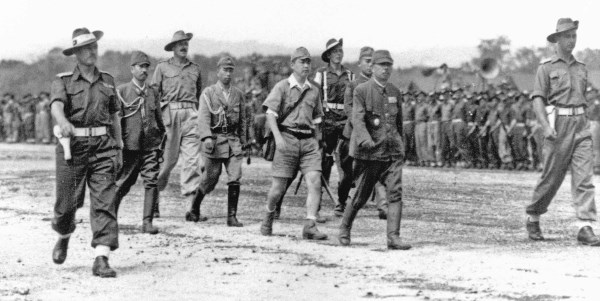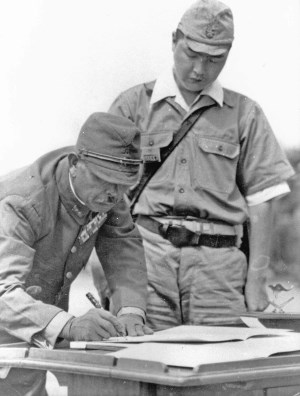
PNGAA Library
The aftermath of war: Charles Betteridge

About 8 pm on 10 September 1945, three Japanese soldiers and an orderly arrived at the area of the 2/7th Battalion at Kairiru near Maprik. They carried a message from General Adachi. They were soon dispatched back with another message instructing the Japanese Commander to report to the Australians on 11 September. The following day, late in the afternoon, General Adachi arrived, carried in a sedan chair by native bearers. This was necessary because he was a very sick man. Adachi was met by an Australian Officer who ordered him to get out of the chair. He was then escorted by the officer in charge and that night the Japanese party was placed in a barbed wire and sago compound. The following morning they all, including Adachi, marched to Kaboibus under heavy escort. Once they were past the Australian lines, Adachi was allowed to get back in his sedan chair because it was clear he was far from well. From Kaboibus, Adachi was driven by Jeep to Yamil and then taken to Hayfield airstrip and flown into Wewak by a Douglas plane.
The official surrender of General Adachi and the 18th Army was timed to take place at 10.15 am on Thursday morning, 13 September 1945, just three days after the surrender of Rear Admiral Santo and the 27th Japanese Naval Force to Major-General Robertson which took place on board the Royal Australian Naval Vessel Fairmile in the Kairiru Strait. The same boardroom table was used for both ceremonies.
The surrender of General Adachi took place at the north end of the Cape Wom Auster airstrip, near Divisional Headquarters. On either side of the airstrip Australian soldiers were lined up. At 10 am the Japanese surrender party arrived in Jeep 58091 and were made to walk down the length of the airstrip under armed escort. For soldiers who watched Adachi and his interpreter walk to the table and sign the document, it was a moment of great excitement and great relief. As Adachi reached the table the Generals saluted and Adachi removed his glove. After signing the documents he handed over his sword and was escorted back to the waiting Jeeps, then he was flown back to Kairiru to organise the capture of the remainder of the Japanese soldiers still in the bush. Later, Adachi was transferred to Rabaul to face war crimes charges.
All the Japanese were shipped over to Muschu Island (about 20 km off Wewak) to a POW camp. Eventually there were 10,000 prisoners on the island. Japanese soldiers, under Australian supervision, ran the camp. The prisoners built themselves all kinds of shelter from primitive huts to comfortable cottages. There was a hospital, always full because many of the Japanese soldiers were in a very weak condition after so many years in the bush. According to a report in the Sun newspaper in December 1945, about 40 Japanese POW were dying each week mainly due to their already weakened constitutions being unable to cope with the onslaught of malaria. It was essential to repatriate, as quickly as possible, the prisoners who were not required for war crimes trials in Rabaul. One thousand one hundred prisoners were returned home to Japan on 27 November 1945, sailing in the disarmed cruiser Kashima. By early March 1946 all other prisoners had left the Wewak area.
On 12 July 1947, Lt General Hatazo Adachi was sentenced to life imprisonment for war crimes. On 10 September 1947 he committed suicide in his cell in Rabaul leaving a letter which is worth quoting in parts as it paints an interesting picture of the man who was in charge of the 18th Army.
During the past three years of operations, more than 100,000 youthful and promising officers and men were lost and most of them died of malnutrition. When I think if this, I know not what apologies to make to His Majesty the Emperor and I feel that I myself am overwhelmed with shame. I have demanded perseverance far exceeding the limit of man's endurance, of my officers and men, who were exhausted and emaciated as a result of my successive campaigns and for the want of supplies. However, my officers and men followed my orders in silence without grumbling and, when exhausted, they succumbed to death just like flowers falling in the wind. God knows how I felt when I saw them dying, my bosom was filled with pity for them though it was to their country that they had dedicated their lives. At that time I made up my mind not to set foot on my country's soil again but to remain as a cloud of dirt in the southern seas with the 100,000 officers and men, never if a time should come when I would be able to return in triumph.
Adachi obviously blamed himself for the appalling death rate but he was unfair to himself. There was very little he could have done to have avoided what did happen except perhaps surrendering at an earlier stage in the war and that was not in the true Japanese tradition.
And what of General Adachi? He was born in Tokyo in 1890 into a family with Samurai traditions. He wrote Tanka and was skilled in calligraphy as well as being an expert in Karate and Kendo. He graduated from the Tokyo Military Academy in 1910 and from the War College in 1922, becoming a member of the Japanese Army General Staff in 1925. He was made a Lieutenant General in November 1942 and took command of the Japanese 18th Army in New Guinea. He had to leave immediately for the war zone and could not attend his wife's funeral.
New Guinea was one of the major battle grounds of World WarII with immense suffering on both sides. Adachi was a brave soldier, but the battles read as a litany of defeats: Buna, Gona, Salamaua, Wewak, Lae, Hansa Bay, Rabaul and Aitape.
One can only imagine this man's anguish. His wife and daughter had both died after long illnesses. He failed the Emperor. After a lifetime of service all his world had come to nothing.

General Adachi being escorted to the surrender table

Signing the surrender